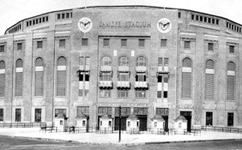The House That Ruth Built
In 1913, the New York Highlanders baseball club moved to the Polo Grounds from their previous home of Hilltop Park, where they had played since their founding in 1903. As part of this move to the field on Coogan’s Bluff along the Harlem River in Manhattan, the team was renamed the New York Yankees.
This new home of the newly-named Yankees was also the home field of the New York Giants, where the Giants had been playing since June 28, 1911. Both teams shared the Polo Grounds through the decade, but the Yankees started to out-draw the Giants in attendance after Babe’s arrival on the team in 1920.
Shortly thereafter, this ballpark-sharing arrangement began to unravel as John McGraw, the owner of the Giants and the Polo Grounds itself, began to resent the Yankees’ ever-growing popularity. Mr. McGraw was not interested in being second dog on his own turf.
In addition, the Giants management was looking to increase revenues by utilizing a larger, more flexible schedule for their games, which they could not do as long as they had another team that they needed to work around to determine their own game schedule. Thus, the Giants began to push the Yankees out of their Polo Grounds. In May of 1922, the Yankees responded by breaking ground on their own ballpark, on 10 acres just across the Harlem River and in view of the Polo Grounds. The new ballpark was built quickly, as construction took under 11 months. The end result was Yankee Stadium, considered by many to be an architectural work of art for its time, with an arched façade that decorated the third deck and became its primary architectural signature.. It was one of the first ballparks to be called a stadium and it was the first to feature three-tiered seating.
 On April 18th, 1923, the first day of the new baseball season, the gates of Yankee Stadium were opened and 74,200 people flooded through turnstiles, while another 25,000 were turned away – an amazing number, given that previous attendance record for a single game was 42,000 for the 1916 World Series in Boston. In an ironic twist, the first game was fittingly played against the Boston Red Sox, Babe’s former team. Even more fitting was that Babe Ruth hit the first homerun in the stadium on the opening day of the new ballpark – a three-run homerun, giving the Yankees the 4-1 win.
On April 18th, 1923, the first day of the new baseball season, the gates of Yankee Stadium were opened and 74,200 people flooded through turnstiles, while another 25,000 were turned away – an amazing number, given that previous attendance record for a single game was 42,000 for the 1916 World Series in Boston. In an ironic twist, the first game was fittingly played against the Boston Red Sox, Babe’s former team. Even more fitting was that Babe Ruth hit the first homerun in the stadium on the opening day of the new ballpark – a three-run homerun, giving the Yankees the 4-1 win.
As a response to Babe’s opening day homerun, sportswriter Fred Lieb referred to Yankee Stadium in his column as “The House That Ruth Built”. It was a nickname that quickly stuck. Given Babe’s great ability to draw a crowd, this reference to Yankee Stadium became a regular term and is still used as the great ballpark’s less-formal name.
Marty Appel, a longtime Yankees publicist, had the opportunity to speak with ex-Yankee, Bob Shawkey, who had pitched on Opening Day. Not only was Bob the winning pitcher, but he also scored the first run. When Marty asked about the event, Bob responded: “Once the Babe homered, the fans cheered forever. Can you imagine anyone paying any attention to me that day? Babe owned the day. And that was just fine; he was born to be in the spotlight. It was his day from beginning to end.”
Claire Ruth, Babe’s second wife, was asked about the event at one point and she said, “I think that was the proudest moment of his life, and I think he believed that it would never have been “The House that Ruth Built” if he hadn’t hit that homerun that day. He definitely talked about it more than any other homerun he ever hit, including his 60th, which, after all, only broke his own record of 59.”
 Babe’s granite memorial is one of the six free-standing granite edifices in Monument Park, an area inside the stadium of gardens and commemorative plaques to some of the Yankee’s baseball greats who played with the Babe or who followed him. Fans can visit the Memorial Park area every game day, as it is open before and after the game.
Babe’s granite memorial is one of the six free-standing granite edifices in Monument Park, an area inside the stadium of gardens and commemorative plaques to some of the Yankee’s baseball greats who played with the Babe or who followed him. Fans can visit the Memorial Park area every game day, as it is open before and after the game.
Announced in 2006, a new Yankee Stadium was built across the street to bring New York baseball fans the facilities and comforts that a modern-era ballpark enjoys. The old stadium will forever be associated with the Babe and recognized as “The House That Ruth Built.” And, while the new stadium is not recognized as “Ruth’s House”, the Yankees have honored the Babe as a part of the new stadium. “Babe Ruth Plaza”, which directs fans to one of main entrances to Yankee Stadium, contains a small memorial to the Babe, a tribute to the best Yankee and player to ever play the game.
Follow Us: